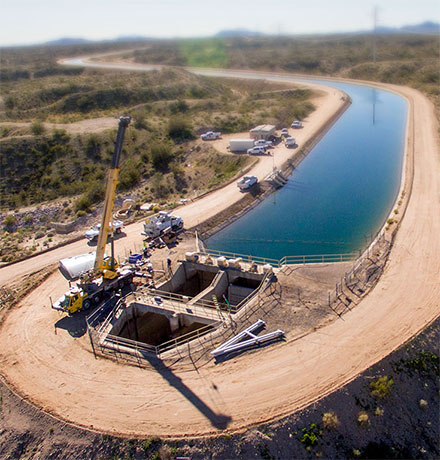Law of the River
Law of the River
U.S. Supreme Court adopts the Doctrine of Equitable Apportionment of benefits for rivers flowing between states. Kansas v. Colorado, 206 U.S. 46. The equitable apportionment doctrine is based on the “cardinal rule” of “equality of right” among states. “Each state stands on the same level with all the rest.” The Court later explains that “equality of right” refers “not to an equal division of the water, but to the equal level or plane on which all the states stand, in point or power and right, under our constitutional system.” Wyoming v. Colorado, 259 U.S. 419, 465 (1922).
Seven basin states organize League of the Southwest in Salt Lake City, Utah, to promote Colorado River development.
Congress authorizes the seven basin states to negotiate and enter into an interstate compact providing for the equitable division and apportionment of the Colorado River.
The Colorado River Commission is organized in Washington, D.C.
The Fall-Davis Report submitted to Congress recommends construction of the All-American Canal in California and a dam at Boulder Canyon in Nevada.
U.S. Supreme Court rules that the doctrine of prior appropriation can be applied between states where each of the states adheres to that doctrine. Wyoming v. Colorado, 259 U.S. 419.

• First agreement to legally connect the states that share the Colorado River water supply
• Designated the Upper and Lower Colorado River Basins, allocating 7.5 MAF/year to each
• Arizona refused to ratify the Compact until 1944
All states, except Arizona, ratify the Colorado River Compact.

• Authorized construction of Hoover Dam
• Apportioned Colorado River water among the Lower Basin states: 2.8 MAF/year to Arizona; 4.4 MAF to California; 300,000 acre-feet to Nevada
California enacts the California Limitation Act, agreeing to limit its use of Colorado River water to 4.4 million acre feet (MAF) per year.
President Hoover declares the Boulder Canyon Project Act to be in effect.
Arizona files suit in the Supreme Court against the Secretary of the Interior and the other six basin states seeking to block implementation of the Boulder Canyon Project Act.
Secretary of the Interior asks California to recommend an apportionment of its share of the Colorado River among water users in that state.
U.S. Supreme Court dismisses Arizona’s action without prejudice, holding that the Boulder Canyon Project Act is a valid exercise of congressional authority and does not purport to abridge any of Arizona’s rights. Arizona v. California (I), 283 U.S. 423.
California Seven Party Agreement among Palo Verde Irrigation District, Imperial Irrigation District, Coachella Valley County Water District, Metropolitan Water District of Southern California, City of Los Angeles, City of San Diego and County of San Diego establishes their relative priorities to Colorado River water.
Metropolitan Water District of Southern California enters into an amended contract with the Secretary of the Interior for delivery of Colorado River water in accordance with the California Seven Party Agreement.
Imperial Irrigation District enters into a contract with the Secretary of the Interior for delivery of Colorado River water in accordance with the California Seven Party Agreement. Contract also provides that the United States will construct Imperial Dam and the All-American Canal.
Palo Verde Irrigation District enters into a contract with the Secretary of the Interior for delivery of Colorado River water in accordance with the California Seven Party Agreement.
City of San Diego enters into a contract with the Secretary of the Interior for delivery of Colorado River water in accordance with the California Seven Party Agreement.
Arizona seeks to file a complaint in the U.S. Supreme Court to perpetuate testimony for a future action arising out of the Boulder Canyon Project Act to be brought against California and others.
The U.S. Supreme Court denies Arizona’s motion. Arizona v. California (II), 292 U.S. 341.
Coachella Valley County Water District enters into a contract with the Secretary of the Interior for delivery of Colorado River water in accordance with the California Seven Party Agreement.
Arizona petitions to file suit against California in the U.S. Supreme Court, seeking to quiet title to Arizona’s equitable share of the Colorado River and to limit California’s equitable share to no more than 4.4 MAF. Arizona also asks for a decree that any other state’s use of Arizona’s equitable share of the Colorado River shall not constitute a prior appropriation or create any right superior to Arizona’s.
The U.S. Supreme Court again denies Arizona’s motion.
Parker Dam is completed.
The seven basin states organize the Committee of Fourteen, comprised of two representatives from each state, to address Colorado River issues.
Metropolitan Water District of Southern California begins diverting water through the Colorado River Aqueduct.
Nevada enters into a contract with the Secretary of the Interior for delivery of 300,000 acre-feet of Colorado River water.

• Apportioned 1.5 MAF/year of Colorado River to Mexico during normal years and specified that Mexico would share proportionately in times of surplus and in reductions due to “extraordinary drought”
• Established the binational International Boundary and Water Commission to implement the Treaty
Arizona ratifies the Colorado River Compact.
The U.S. Supreme Court retreats somewhat from its ruling in Wyoming v. Colorado, holding that “strict adherence to the priority rule” when equitably apportioning the flow of a river among prior appropriation states “may not be possible.” While priority remains the “guiding principle,” the Court identifies a number of additional factors that may be taken into account. “For example, the economy of a region may have been established on the basis of junior appropriations. So far as possible those established uses should be protected though strict application of the priority rule might jeopardize them.” Nebraska v. Wyoming, 325 U.S. 589, 618.
Arizona seeks legislation authorizing Central Arizona Project (CAP). California opposes.
The Upper Colorado River Basin Compact is signed by Arizona, Colorado, New Mexico, Utah and Wyoming.
U.S. Senate passes CAP legislation.
CAP legislation dies in U.S. House committee.
U.S. House Committee on Interior and Insular Affairs indefinitely postpones action on CAP legislation “until such time as the use of the water in the Lower Colorado River Basin is either adjudicated, or a binding, mutual agreement as to the use of the water is reached by the states of the Lower Colorado River Basin.” (The Colorado River Board of California later boasted that it had been “instrumental” in achieving this result.)
U.S. Senate passes CAP legislation for the second time.
Arizona files suit against California in the U.S. Supreme Court to establish its right to Colorado River water.
U.S. Supreme Court grants Nevada’s motion to intervene in Arizona v. California (IV).
U.S. Supreme Court denies California’s motion to join the four Upper Colorado River Basin states in Arizona v. California (IV), but joins New Mexico and Utah as Lower Colorado River Basin states.
U.S. Supreme Court decision in Arizona v. California.
Reclamation completes Glen Canyon Dam (Lake Powell).
In reaction to the U.S. Supreme Court’s opinion, California immediately announces that it will oppose authorization of CAP.

• After a decade of deliberation, the U.S. Supreme Court delivered its opinion in favor of Arizona, upholding its designated 2.8 MAF/year share of mainstream Colorado River water
• Effectively established the U.S. Secretary of the Interior as the Lower Basin “water master”
Western governors establish the Western States Water Council to avoid interstate conflict by developing regional solutions to water problems.
Meeting in Washington, D.C., representatives of the seven basin states reach agreement on four general principles:
•The Lower Basin’s temporary use of unused Upper Basin water will not jeopardize Upper Basin rights.
•Importation of water from outside the Colorado River Basin is essential and pending legislation should authorize construction of works to import at least 2.5 MAF.
•Imported water should be available no later than 1980, although there appears to be sufficient water to meet all needs, including CAP, until the 1990s.
•Satisfaction of the Mexican treaty obligation should be a national obligation and the first priority for imported water.

• Authorized the Bureau of Reclamation to fund and construct the Central Arizona Project – learn more here
• Created a junior priority in the Lower Basin for CAP water and for any new Arizona contracts entered after 1968 in times when insufficient mainstem Colorado River water is available to deliver a total of 7.5 million acre-feet to Arizona, California and Nevada
• Directed the U.S. Secretary of the Interior to develop a plan for augmenting the Colorado River supply
• Declared the Mexican Treaty delivery obligation a “national obligation”
U.S. Secretary of the Interior adopts Criteria for Coordinated Long-Range Operation of Colorado River Reservoirs.
U.S. and Mexico enter Minute 242 to the 1944 Treaty addressing salinity of water delivered to Mexico at Morelos Dam.
The Colorado River Basin Salinity Control Act authorizes salinity control projects above and below Imperial Dam, including the Yuma Desalination Plant.
U.S. Secretary of the Interior adopts regulations for off-stream storage and release of unused apportionment enabling interstate water banking in the Lower Basin.
U.S. Secretary of the Interior adopts Interim Surplus Guidelines establishing criteria for declaring surpluses in the Lower Basin states.
Interim surplus determinations are suspended after California parties fail to complete a quantification settlement agreement by the December 31, 2002 deadline in the Interim Surplus Guidelines.
United States enters into Colorado River Water Delivery Agreement with Imperial Irrigation District, Coachella Valley Water District, Metropolitan Water District of Southern California and San Diego County Water Authority. The agreement memorialized the U.S. Secretary of the Interior’s commitment to deliver water to California contractors in accordance with the Quantification Settlement Agreement.
Quantification Settlement Agreement executed memorializing U.S. commitment to deliver water to California.
The U.S. Secretary of the Interior announces her intent to develop guidelines for conjunctive management of Lakes Powell and Mead and shortage sharing in the Lower Basin by Dec. 31, 2007, and initiates a public process toward that end. The Basin States are encouraged to reach agreement.
Basin States submit a Preliminary Proposal Regarding Colorado River Interim Operations, including coordinated management of Lake Powell and Lake Mead and shortage guidelines for the lower basin.
The U.S. Supreme Court enters its Consolidated Decree in Arizona v. California.

• Established a shortage framework for the Lower Basin
• Incentivized storage of water in Lake Mead through Intentionally Created Surplus (ICS)
• Coordinated operations of Lake Powell and Lake Mead
• Expire in 2026
U.S. and Mexico enter Minute 319 to the 1944 Treaty establishing criteria to share in water surpluses and shortages.
Reclamation releases the Colorado River Basin Water Supply and Demand Study.
Environmental pulse flow and base flow, allowed by Minute 319 to the 1944 Treaty, are released through the Colorado River channel in Mexico to start new vegetation for wildlife habitat.
Minute 323 expanded collaboration and sharing of shortage risks and surplus opportunities between Mexico and the U.S. and provided for U.S. investment in water infrastructure and environmental projects in Mexico. It also established a work group to investigate binational desalination in the Sea of Cortez, as well as the binational water scarcity contingency plan.

• Lower Basin highlights (learn more about Arizona’s implementation plan here):
- Supplements the 2007 Interim Guidelines
- Provides additional flexibility for the creation, storage and delivery of ICS
- Created a “Tier Zero” at Lake Mead, requiring contributions to Lake Mead earlier, starting at elevation 1090’, and increased contributions at lower elevations
- California agrees to make contributions to Lake Mead starting at elevation 1045’
- Provided for the protection of Lake Mead elevation 1020’ – 500+ Plan
Upper Basin highlights:
- Designed to minimize the risk of Lake Powell falling below elevation 3525’ and ensure compliance with the Colorado River Compact
- Establish foundation for the storage of water in the Upper Basin as part of a demand management program that may be developed in the future









